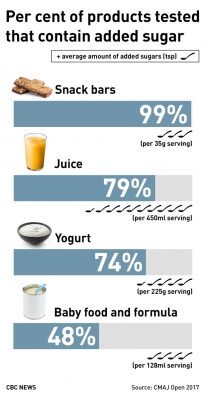WHY ‘YOU REALLY NEED TO BE A DETECTIVE’ WHEN READING FOOD LABELS
Two-thirds of food and beverages tested by a group of Ontario researchers, including baby foods and products marketed as healthy, were found to contain added sugar.
The researchers, from Public Health Ontario and the University of Waterloo, examined the ingredients of 40,829 products sold in March 2015 at a national grocery retailer.
In a study published in Thursday’s issue of CMAJ Open, Erin Hobin and her team searched for 30 different added sugar terms, ranging from sugar to dextrose, high-fructose corn syrup, glucose, fructose and fruit juice concentrate.
Dietitians say added sugars are a concern because they tend to be consumed in much larger quantities than naturally occurring sugars found in foods such as bananas or milk.
Added sugars are a sign of more food processing, which has health implications, including weight gain and high blood pressure. The World Health Organization and Heart & Stroke now recommend that people limit their sugar intake to no more than 10 per cent of overall calories, or about 12 teaspoons a day
“It definitely is tricky,” Hobin said in an interview. “You definitely need to know what you are looking for when you are scanning the ingredients list, and you really need to be a detective and take your time.”
Added sugars are defined as all sugars added to foods by the manufacturer plus the sugars naturally present in honey, syrups and fruit juices.
Examples of names for sugar include fruit juice concentrate, dextrose and high-fructose corn syrup. For more, see “Sugar’s on the food label, but …”
Products you might suspect contain the most added sugar, such as candy or chocolate, showed the highest sugar content.
FRUIT JUICE PROCESSING
“What we also found was that some of the products that are marketed as healthy also frequently contain added sugar. So that included breakfast cereals, granola bars and a lot of fruit juices,” Hobin said.
Sarah Nowak of Toronto is the mother of three girls, ages six, three and 18 months.
“These, I thought, were just dried fruit,” Nowak said as she examined the front of one box. “Once again, where are the ingredients? Apple puree, concentrated juices, more juices, blueberry juice, carrot juice.”
When whole fruits and vegetables are processed, nutrients are stripped away, Hobin explained.
“You are just left with the fruit juice concentrate that is used as a sweetener, so it is put back into products to sweeten up the product.”
Almost half of all infant formulas and baby food studied also listed added sugars as part of their ingredients.
Nowak said she wished the labels were more transparent. “It makes me feel a little bit duped,” she said.
The researchers suspected a large proportion of products on grocery store shelves contained added sugar, but there was little empirical data. Now, they have a snapshot.
Some evidence suggests that if you feed sugary food to young children, then their palate adjusts, and they grow more attracted to that in the future, said Bill Jeffery, executive director of the Centre for Health Science and Law in Ottawa. “It may be cultivating a lifelong market.”
Fruit juice concentrate that food processors use as sweetener has the nutrients stripped away, said Erin Hobin of Public Health Ontario. (CBC)
If food labels indicated products weren’t very healthful, then sales would decline.
“They have a strong vested interest in making sure that the nutrition labeling is as useless as possible, to be candid,” Jeffery said.
In December, Health Canada announced changes related to the list of ingredients and nutrition facts table — the information boxes on the back of food products.
The federal government won’t require labelling of added sugars.
GROUP ADDED SUGARS TOGETHER
Asked why, a departmental spokeswoman said, “Added sugars are ingredients that manufacturers add to their products and that must be declared in the list of ingredients.
“The Nutrition Facts table declares the amount of nutrients, rather than ingredients. On the Canadian Nutrition Facts table, the amount of added sugars in the food is included in the amount of total sugars, which is consistent with the approach to all other nutrients. Laboratory tests cannot distinguish between naturally occurring and added sugars.”
Health Canada is requiring manufacturers to group all added sugars together in the ingredients list.
Food & Consumer Products of Canada, an industry association, did not immediately respond to requests for comment from CBC News.
The analysis did not include fresh fruits or vegetables, fresh meat, raw ingredients (water, baking ingredients, coffee, tea, fats and oils, etc.) and non-food items (such as natural health products or nutrition and protein supplements).
Credit: http://www.cbc.ca/news/health/sugar-added-processed-foods-canada-1.3932245

